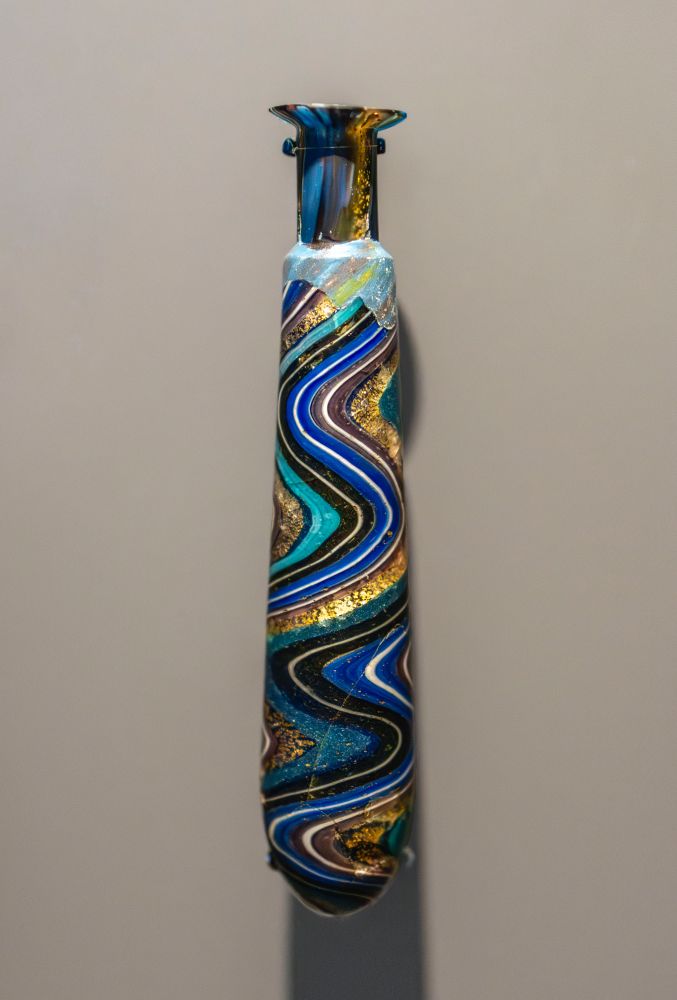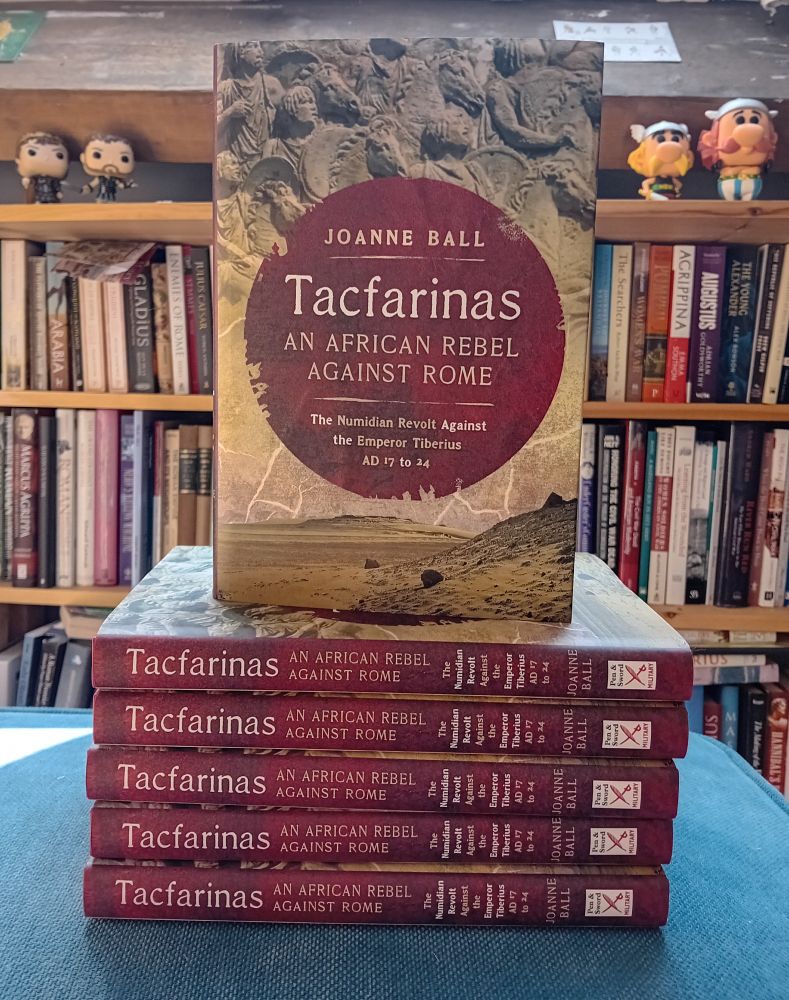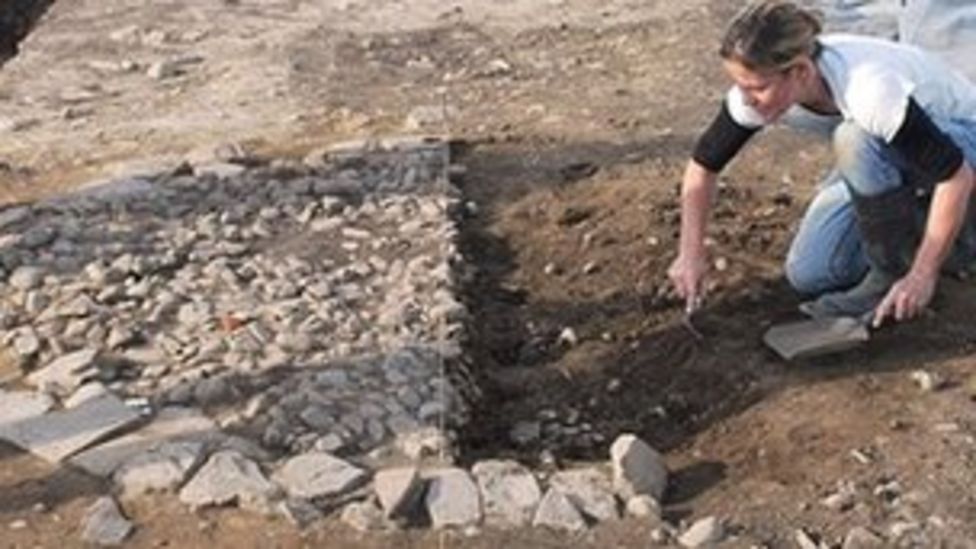
#RomanFortThursday
Forden Gaer, probably the Lavobrinta of the Ravenna Cosmography, lies on the line of the road which connected Caersws and Wroxeter (Viroconium). The fort occupies a slight rise above the east bank of the River Severn.
#Archaeology #History #Roman #Military
30.10.2025 11:37 — 👍 55 🔁 12 💬 1 📌 2

Fort Ala Nova, or Schwechat Fort, is a former Roman cavalry fort (alae fort for 500 horsemen) within the Upper Pannonian Limes. The fort was in the municipality of Schwechat. In the picture excavation area between Alanovaplatz and Wienerstraße in 2010. #RomanFortThursday
30.10.2025 07:45 — 👍 30 🔁 5 💬 1 📌 0
It’s great to been back on the Carlisle Roman Excavation once again #HadriansWall #Archaeology
29.10.2025 16:56 — 👍 28 🔁 1 💬 2 📌 0

The Road to Mons Gaupius: Alan Montgomery - Glasgow Life
Aye Write 2025 presents The Road to Mons Gaupius: Alan Montgomery
I am excited to announce that I'll be talking about Roman Scotland and my book The Road to Mons Graupius in Glasgow as part of the Aye Write festival. I'll be at the Mitchell Library on Sunday 9th November at 12.45pm - tickets available here: www.glasgowlife.org.uk/event/1/the-...
#RomanSiteSaturday
27.09.2025 07:34 — 👍 55 🔁 21 💬 0 📌 0
The photo was taken at the Caesar and Cleopatra exhibition in Speyer, having been loaned by the Vatican Museum.
29.10.2025 06:39 — 👍 39 🔁 2 💬 0 📌 0

A marble relief depicting a Roman warship with rows of oars and soldiers on board. The figures wear helmets and carry shields, while the ship features ornate carvings, including a decorative prow and architectural elements like a tower. Displayed against a blue-lit museum background
#ReliefWednesday!
A Roman marble relief of a warship. Found in the necropolis of Praeneste (Latium), late 1st century BC.
The relief presumably belonged to the tomb of a Roman veteran who had served on Octavian’s side at the Battle of Actium in 31 BC.
📷 me
🏺 #archaeology
29.10.2025 06:39 — 👍 240 🔁 58 💬 3 📌 1

The pots
Your average Roman cooking ware jars from the Jewry Wall Roman Experience. In front a grey ware pot and behind it a coarseware pot. #FindsFriday
24.10.2025 04:22 — 👍 45 🔁 11 💬 0 📌 0

Beautiful black and white photographic portrait of a brass cavalry helmet visor in the shape of a man’s face with decorated hair.
For #FindsFriday a Roman helmet visor from Trimontium (Newstead) a beautiful photographic illustration from the stunning 2-volume report of the excavations, A Roman Frontier Post by James Curle 1911. The pit content records are the stuff of dreams. From Pit LVII “at 15 feet a bronze helmet mask.”
1/
24.10.2025 10:12 — 👍 49 🔁 10 💬 3 📌 1

2nd-3rd century CE Roman Frescoe unearthed during the construction of Termini Railway Station in Rome courtesy of Mary Harrsch. #FrescoFriday #RomanArchaeology #Archaeology
24.10.2025 11:14 — 👍 6 🔁 3 💬 0 📌 0

Worn away lion depicting paw on head, siting on plinth
This #findsfriday we have a bronze terminal of a chair in the form of a lioness seated on a rectangular pedestal, its front paw we think is on a human head, with stamped decorations on the sides. This was found in 1910 at Newbury Water Works, Berkshire.
24.10.2025 09:11 — 👍 23 🔁 7 💬 2 📌 0

On September 14th, 81 CE, Domitian became Emperor of Rome after Titus’s sudden death. Known for his military campaigns, he expanded the Rhine-Danube limes and made advances in Britain. But consolidation in Scotland stalled due to wars on the Danube, costing Rome two legions. By I, Sailko, CC BY 2.5
14.09.2025 07:30 — 👍 12 🔁 2 💬 1 📌 0

Curved rectangular copper-alloy shield boss from the River Tyne at South Shields (GBR) with a hemispherical boss, engraved and punctim decoration, and selective tinning. Image: © The Trustees of the British Museum (CC BY-NC-SA 4.0)

Fragmentary (top right corner with most of the dome) curved, rectangular, copper-alloy shield boss similar to the example from the River Tyne (GBR). Found at Vindonissa (CHE). Image: DerHexer (CC BY-SA 4.0)
Shields up! It's #ShieldSunday and here's the Tyne #scutum boss and its less-complete twin from Vindonissa. The first is an excellent example of selective tinning, something discussed in detail at #ROMECXXI.
20.07.2025 05:55 — 👍 31 🔁 3 💬 0 📌 0

A gold band alabastron, with irregular bands of colored glass (cobalt blue, green, white, and black) snaking across the surface of this elegant vessel. The opulent gold bands are in fact gold leaf sandwiched between layers of colorless glass. Gold band glass was a luxury ware and this alabastron, or perfume flask, would have been owned by a prosperous Roman woman.
The term alabastron comes from alabaster, the material from which containers of this shape, used for perfume and scented oil, were originally made in Egypt. In the Roman Empire, the use of gold band glass was initially limited to the creation of alabastra, but the medium was gradually adapted for the creation of a variety of other shapes.
Honestly, I can never get enough of ancient glass. The vibrant colors, clever forms, and even the use of gold. This alabastron (perfume or scented oil flask) has swirls of gold between bands of colored glass. 1/ 🏺
📸 me
20.07.2025 21:29 — 👍 299 🔁 57 💬 4 📌 3

For #RomanSiteSaturday here’s our test pit last Saturday behind the old Rose and Crown pub in St.Albans. Lots of Roman pottery. My 📷 #StAlbansMuseums
19.07.2025 10:00 — 👍 55 🔁 13 💬 2 📌 1

Hadrian sits on an upright chair and watches as Sabina is carried away from her funeral pyre on the back of the torch-bearing personification of Aeternitas. At Hadrian’s feet, a reclining semi-nude youth symbolises the Campus Martius.
Now in Palazzo Nuovo, Capitoline Museums, Rome.
#ReliefWednesday - Relief from the Arch of Portugal in Rome depicting the apotheosis of the wife of Hadrian, Sabina. When Sabina passed away, Hadrian constructed a monumental altar in her honour, likely located on the northern Campus Martius, to which this large marble relief may have belonged.
16.07.2025 16:18 — 👍 31 🔁 8 💬 0 📌 0

A section of the Roman Wall at St. Albans which was built between AD 265 to 270 to defend the Roman city of Verulamium. The surviving sections are located in Verulamium Park which is a short walk from the city centre. 📸 My own. #RomanSiteSaturday #RomanBritain #StAlbans
05.07.2025 06:42 — 👍 164 🔁 24 💬 0 📌 1

Bronze bust with head of the emperor with beard & curly hair.
Marcus Aurelius (head of life-size statue)
Bronze. 160 to 170 AD
Found Dunaszekesö, #Hungary
The statue perhaps depicted the #Roman Emperor as a general & so would honour his supreme commander role.
In #MarcusAurelius exhibition, #Trier
Loaned by Janus Pannonius Museum, #Pécs
#RomanArchaeology
03.07.2025 06:33 — 👍 119 🔁 23 💬 2 📌 3


#OnThisDay - 1 July - in AD 69 the troops of Tiberius Julius Alexander in Egypt were the first to swear allegiance to Vespasian as emperor. He would use this date as his 'dies imperii'. 🏺
Image: RIC 2.1 Vespasian 1381; British Museum (1923,1015.5). Link - numismatics.org/ocre/id/ric....
01.07.2025 08:27 — 👍 35 🔁 6 💬 0 📌 0

The inscription
This is the Pilate stone naming Pontius Pilate, a prefect of the Roman province of Judaea in the 1st century AD. It was discovered at Caesarea Maritima in 1961.
[DIS AUGUSTI]S TIBERIÉUM
[...PONTI]US PILATUS
[...PRAEF]ECTUS IUDA[EA]E
[...FECIT D]E[DICAVIT] #EpigraphyTuesday
01.07.2025 04:05 — 👍 39 🔁 6 💬 2 📌 1

A Roman building stone which was found at Carrawburgh Roman Fort on Hadrian’s Wall in Northumberland recording that ‘The Thruponian Century (built) 24 feet.’ The stone is now on display in the museum at Chesters Roman Fort. 📸 My own. #EpigraphyTuesday #RomanBritain
01.07.2025 06:20 — 👍 65 🔁 9 💬 1 📌 0

Really thrilled that my second book is now published! It explores the life of Tacfarinas, a C1st AD auxiliary soldier-deserter-bandit-rebel who came to lead a revolt against #Rome in NW Africa during the early reign of Tiberius. He is a truly fascinating figure in #Roman history! 🏺AncientBlueSky
30.06.2025 14:48 — 👍 254 🔁 55 💬 13 📌 4

If you're at @imc-leeds.bsky.social next week, you should definitely drop by for this session where I'll try my best to humbly stand on the shoulders of the giants in this session.
01.07.2025 07:18 — 👍 21 🔁 6 💬 2 📌 1

You might expect Royston to have been a Roman town. It wasn’t.
Join us on Wednesday 23 July for a fascinating talk by Keith Fitzpatrick-Matthews as we explore why a town didn't grow up here and how the area was organised and populated in Roman times.
🗓️ Wednesday 23 July, 7:15pm
💻 buff.ly/qqyLYtX
30.06.2025 18:05 — 👍 3 🔁 1 💬 0 📌 0

CFP for Borders, Boundaries, Barriers: Real and Imagined in the Middle Ages (20-21 April 2026). Deadline 15 September 2025.
28.06.2025 19:40 — 👍 80 🔁 40 💬 1 📌 7

An artist's impression of a huge white triumphal roman arch with steps leading up from a port, surrounded by red brick buildings on either side
#RomanFortThursday The Gateway to Roman Britain - the massive Triumphal Arch of Rutupiae (Richborough in Kent), clad in white Carrara marble from Italy, was a statement of Roman power at the entrance to Britannia
Art by Peter Lorimer
#archaeology #ancienthistory #art #romanempire #romanbritain
26.06.2025 09:30 — 👍 49 🔁 15 💬 4 📌 0

What does following Hadrian's first voyage for four years mean? You trace his journey across three continents, drive thousands of kilometres, visit hundreds of ancient sites, take thousands of photos, and spend countless hours researching at home. A thread with all 21 articles published on my blog.
19.06.2025 13:50 — 👍 161 🔁 30 💬 4 📌 3
This comedic image is a lithograph by George Spratt, used as the frontispiece in Walter Scott’s 1816 novel, 'The Antiquary'.
19.06.2025 10:32 — 👍 7 🔁 1 💬 0 📌 0
Collection volunteer for English Heritage and St.Albans museums. Co-curator of upcoming ‘Religion in Verulamium’ exhibition. Retired archaeology and Latin teacher with recent MA in Classical Archaeology. Posts will largely be about archaeology (or beer)
News about Classics, Antiquity and Religious Studies in Ottawa and beyond.
Actualités sur les études anciennes et les sciences des religions à Ottawa et ailleurs.
🎻 Orchestra based in Colchester, Essex, UK
🎺 Founded in 1966
🎼 Concerts held in St Botolph’s Church
🎶 Not-for-profit organisation
🌍 sbms.org.uk
Interests - Walking, Cycling, Travel, History, Nature. Retired Head of Humanities, European. 🇪🇺
The official Bluesky account of the Oxford University Byzantine Society.
Follow for updates about our activities & for all things Late Antique and Byzantine at Oxford!
archaeology, history, environment, quirky stuff -- love London, arts, travel -- writer, organiser, modest activist/stirrer 🏺
Astronomer Royal for Scotland, Professor of Astrophysics, Edinburgh University. Director of the German Centre for Cosmological Lensing, RUB. #LongCovid (She/her)
History Group who did a dig & got the bug.
Grŵp hanes a wnaeth gloddio a chael y byg
Hadrianophile
"omnium curiositatum explorator"
#Hadrian1900
https://followinghadrian.com/
Silver Jewellery Maker Science, Art, Poetry, Writing, History, Mythology and the Weird, Sterling Silver Jewellery at https://folksy.com/shops/SamanthaStanley
Sussex via Dorset.
Please don't DM me. I'm not age verified.
Boycott The USA Slava Ukraine🇺🇦
We are a UK-wide educational charity that helps champion and promote participation in archaeology. We run the Young Archaeologists’ Clubs and the annual Festival of Archaeology. Join us to help shape the future of archaeology.
https://www.archaeologyuk.org
Editor with The New York Times in London. My interests are broad: Hong Kong and Asia; Occitanie and France; Geneva and Switzerland. Rugby and other sports.
Design, Shakespeare, biscuit art. Senior Lecturer in Research & Innovation at the Royal Welsh College of Music & Drama. Book: Shakespeare in Elizabethan Costume (Bloomsbury Arden Shakespeare). She/her.
Archaeopress is an independent press specialising in archaeology and related heritage topics.
Header photo © Gavin McGuire & the Sissi Archaeological Project
Volunteer Trail Ranger since May 2010 on Portgate to Heavenfield section of Hadrian's Wall Path National Trail, Wall miles 22 to 25.
The Society's Blue Sky feed run by the Director with an interest in all things archaeological especially archaeological method, geophysics and fieldwork. Have been known to publish a few things on coins and stats too. Always looking for speakers!
"The Britons live in such a state of independence
that they do not obey
even their own chiefs
except by their own good pleasure."
Cassius Dio
#Archaeology #History of #RomanBritain
Archaeologist | Orienteerer | Wanderer. Professor of Funerary Archaeology at the University of York, specializing mostly in the central European Neolithic.
Michael Smith. Author, printmaker, translator and illustrator of medieval romances. Whimsy, art. Published by Wilton Square Books. PhD research University of York. Follows the Blackburn Rovers. www.mythicalbritain.co.uk.



































